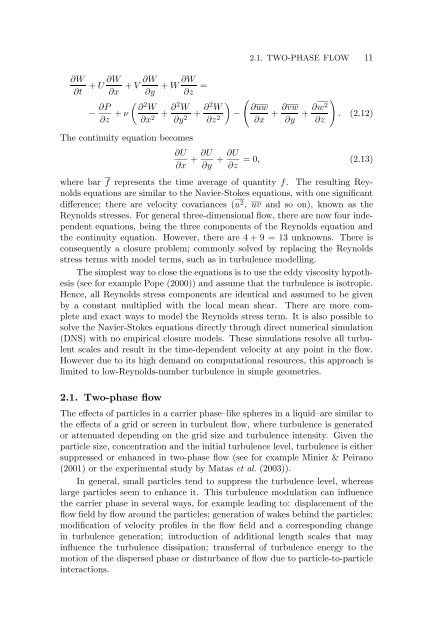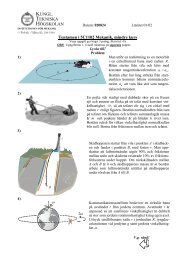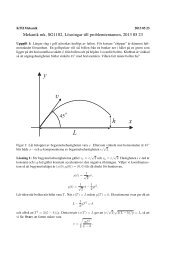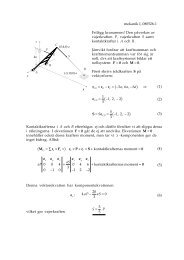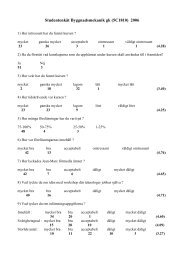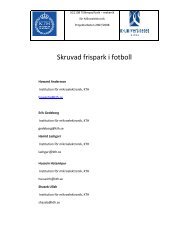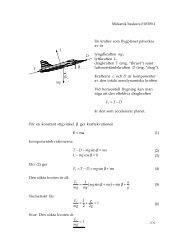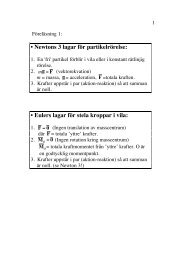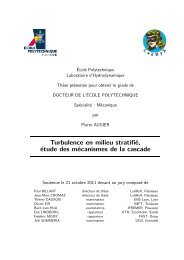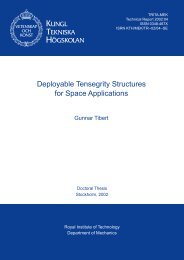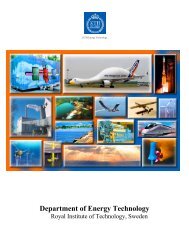Fluid mechanics of fibre suspensions related to papermaking - DiVA
Fluid mechanics of fibre suspensions related to papermaking - DiVA
Fluid mechanics of fibre suspensions related to papermaking - DiVA
Create successful ePaper yourself
Turn your PDF publications into a flip-book with our unique Google optimized e-Paper software.
∂W<br />
∂t<br />
+ U ∂W<br />
∂x<br />
− ∂P<br />
∂z<br />
+ ν<br />
2.1. TWO-PHASE FLOW 11<br />
∂W ∂W<br />
+ V + W<br />
∂y ∂z =<br />
2 ∂ W<br />
∂x2 + ∂2W ∂y2 + ∂2W ∂z2 <br />
<br />
∂uw ∂vw ∂w2<br />
− + + . (2.12)<br />
∂x ∂y ∂z<br />
The continuity equation becomes<br />
∂U<br />
∂x<br />
+ ∂U<br />
∂y<br />
+ ∂U<br />
∂z<br />
= 0, (2.13)<br />
where bar f represents the time average <strong>of</strong> quantity f. The resulting Reynolds<br />
equations are similar <strong>to</strong> the Navier-S<strong>to</strong>kes equations, with one significant<br />
difference; there are velocity covariances (u 2 , uv and so on), known as the<br />
Reynolds stresses. For general three-dimensional flow, there are now four independent<br />
equations, being the three components <strong>of</strong> the Reynolds equation and<br />
the continuity equation. However, there are 4 + 9 = 13 unknowns. There is<br />
consequently a closure problem; commonly solved by replacing the Reynolds<br />
stress terms with model terms, such as in turbulence modelling.<br />
The simplest way <strong>to</strong> close the equations is <strong>to</strong> use the eddy viscosity hypothesis<br />
(see for example Pope (2000)) and assume that the turbulence is isotropic.<br />
Hence, all Reynolds stress components are identical and assumed <strong>to</strong> be given<br />
by a constant multiplied with the local mean shear. There are more complete<br />
and exact ways <strong>to</strong> model the Reynolds stress term. It is also possible <strong>to</strong><br />
solve the Navier-S<strong>to</strong>kes equations directly through direct numerical simulation<br />
(DNS) with no empirical closure models. These simulations resolve all turbulent<br />
scales and result in the time-dependent velocity at any point in the flow.<br />
However due <strong>to</strong> its high demand on computational resources, this approach is<br />
limited <strong>to</strong> low-Reynolds-number turbulence in simple geometries.<br />
2.1. Two-phase flow<br />
The effects <strong>of</strong> particles in a carrier phase–like spheres in a liquid–are similar <strong>to</strong><br />
the effects <strong>of</strong> a grid or screen in turbulent flow, where turbulence is generated<br />
or attenuated depending on the grid size and turbulence intensity. Given the<br />
particle size, concentration and the initial turbulence level, turbulence is either<br />
suppressed or enhanced in two-phase flow (see for example Minier & Peirano<br />
(2001) or the experimental study by Matas et al. (2003)).<br />
In general, small particles tend <strong>to</strong> suppress the turbulence level, whereas<br />
large particles seem <strong>to</strong> enhance it. This turbulence modulation can influence<br />
the carrier phase in several ways, for example leading <strong>to</strong>: displacement <strong>of</strong> the<br />
flow field by flow around the particles; generation <strong>of</strong> wakes behind the particles;<br />
modification <strong>of</strong> velocity pr<strong>of</strong>iles in the flow field and a corresponding change<br />
in turbulence generation; introduction <strong>of</strong> additional length scales that may<br />
influence the turbulence dissipation; transferral <strong>of</strong> turbulence energy <strong>to</strong> the<br />
motion <strong>of</strong> the dispersed phase or disturbance <strong>of</strong> flow due <strong>to</strong> particle-<strong>to</strong>-particle<br />
interactions.


